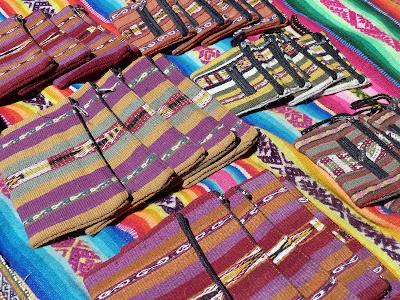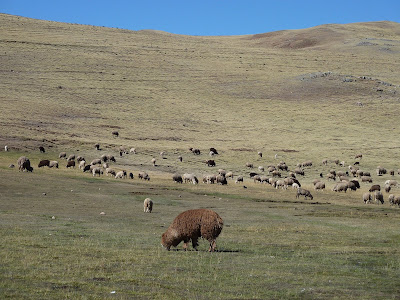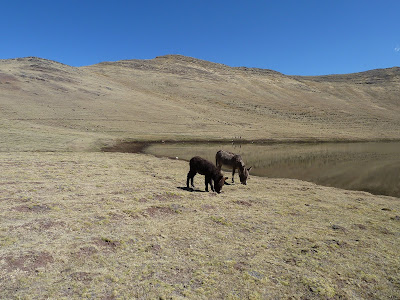I would not hesitate to characterize Peru as a tourist haven, so I have been particularly eager to venture off the beaten path and explore parts of Peru untouched by tourists. Yesterday, I accomplished just that.
At 5:00am, Kie and I struggled out of bed ready to start our day. At the breakfast table, we heard screams coming from outside: “por favor, por favor, por favor!” As we went to investigate, we saw a man on the street kneeling in a prayer-like position (we think he was heavily intoxicated). Our homestay family awoke and called the police. They arrived 10 minutes later and gave resolution to the situation.
As we got ready to leave the house, our homestay family in Cuzco (we jokingly refer to them as our Peruvian parents) expressed worry, as a parent would, about leaving the house before dawn. We assured Tula (our Peruvian mother) that we would be fine and she should not worry. We walked up the street to the bridge – our meeting point with the Peru Leaders (individuals tasked with supervising the Mosqoy students in
Casa Mosqoy). 5:30am came and went (our agreed meeting time). We waited. And waited. And waited some more. Just as we were about to hop on a
combi and attempt to find our own way to Q’enqo (an off-map community), the Peru Leaders arrived at 5:55am. I pointed to my watch as if it would mean something to them, but I am thoroughly confident that my point was not received.
The four of us (Kie, myself, and two Peru Leaders – Adrian and Elvira) jumped into a taxi headed for the bus/
combi terminal (
read: open-space with 3-4 idling buses). We boarded a
combi along the Pisac route, and disembarked in a small town called Ccorao. We walked along the dirt road in the direction of our meeting point with the President of the weaving community. There was a thick layer of frost on the ground and the temperature was bone-chilling cold. I immediately regretted my decision to bring to South America only one pair of yoga pants and wondered how I would survive the cold nights in the weaving villages.
We stumbled upon a small road-side store and used a public telephone to call Bacelio, the President of the Q’enqo weaving community. He answered from Cuzco. “Cuzco?” I asked. Yes, Bacelio was in Cuzco. It became apparent that somewhere the lines were crossed between Bacelio and the Peru leaders. We asked Bacelio to return to Ccorao and meet us on the dirt road leading into town, as agreed upon (according to the Peru Leaders). The four of us turned around and walked back towards the main road. Half an hour later, Bacelio appeared, and we jumped into a taxi leaving for Q’enqo – a small weaving community nestled in the Andean mountain range. The drive was at least an hour, along a rocky/unmarked trail (I felt sorry for Bacelio, who had to ride in the hatch). I wondered to myself if taxi drivers incur as much in damage to their vehicles as they receive in payment.
We arrived in Q’enqo just before 9:00am, and were welcomed into Bacelio’s home. He served tea, coffee and bread and we discussed the itinerary for the day. The Peru Leaders raised to Bacelio issues the leaders have been experiencing, as of late, with Mosqoy students. On Bacelio’s recommendation, we paid a visit to one of the student’s families. Just as we were about to leave, I was reminded of why I should not have had coffee to drink – a natural diuretic. I pushed open the door to the restroom and was confronted with an African-style toilet (essentially, a hole in the ground with two footsteps). I sat pondering for a few minutes, wondering if I could manage the day if I were to pass on the opportunity. Although I had lived in Africa and encountered nothing but this style of toilet, I have somehow never managed to master the ability.
We were welcomed by the student’s family. The family spoke only Quechua (a dialect unique to Andean communities), so Kie and I sat on a wooden log as the Peru Leaders spoke with the student’s parents. I contributed a nod of the head every few minutes or so, to communicate to the family that I was engaged and in the loop of what was going on. Although I could not understand what was being said, I could see disappointment in the mother’s eyes. I studied her facial expressions closely throughout the meeting to see if I could make out what the Peru Leaders were saying.
We spent about an hour at the student’s home and then walked down the dirt road to Bacelio’s home where we would meet with the weavers. We sat in the sun and were served potato soup. Not too long after, we were joined by the weavers and our meeting began. With the help of Adrian and Elvira, I explained to the community our aim of establishing a volunteer service program, wherein Mosqoy students would give back to the weaving communities in the Sacred Valley region, and asked about needs in the community of Q’enqo. Bacelio explained the need for Spanish and cooking classes as well as the desire for administrative/tourism support from Mosqoy students. Another weaver raised the need for family planning workshops and increased education around opportunities for youth. I filled pages of my notebook with notes and promised to return to the community in mid-August to further discuss these project ideas.
I thanked Bacelio and the weavers and inquired about the textile order I was to pick-up and pay for on behalf of the Q’ente Textile Revitalization Society. Within a matter of minutes, the weavers left and returned with the textile pieces they were responsible for making. The pieces were laid out on a blanket for me to inspect and we began the long, arduous process of labeling and recording each piece. I settled payment with Bacelio and we were invited, once again, to eat – this time, cheese and bread that I had purchased on behalf of Q’ente and gave as an offering to the community, fresh tomatoes and cucumbers and an enormous pile of fire-roasted potatoes.
Bacelio explained that our taxi would not return for 2 or so hours, so the four of us agreed to attempt the 3-hour hike back to Ccorao. Although the trail was challenging and largely unmaintained (I struggled to catch my breath climbing up at least one mountain), we were rewarded with spectacular views of rolling mountains, a tranquil lake (Lago Q’oricocha) and herds of animals in their natural habitat - wild pigs, sheep, alpacas, and donkeys. I smiled to myself, knowing that, often, the road less traveled, is the road most rewarding.
We found ourselves back in Ccorao just before 4:00pm. We sat waiting on the paved road for a
combi heading in the direction of Cuzco. Four
combis passed us by. The
combis were so full that people were pressed up against the front, side and back windows. I could feel my stomach turning, not sure what this would hold for the 30 minute bus ride back to Cuzco. A few minutes later, a
combi stopped and we were quick to jump on and secure a place to stand. The
combi was stale and I had little room to breathe, sandwiched in between locals. The churning in my stomach was worsening and I began to feel a combination of dizziness and faintness. It was in this moment that I really began to worry that I would not make it back to Cuzco without seeing the contents of my stomach somewhere in the
combi. I rested my head on the seat in front and tried not to think about the moments impending. As we approached Cuzco, the bus became half-empty and I welcomed the opportunity to sit and encourage my stomach to calm. Thoughts of the day ran through my head, and I tried to rationalize which meal had caused me upset. “Las papas” (potatoes), Elvira said. “Did you eat the potatoes?” “Yes,” I said groaning and holding my stomach. “They were not clean,” she explained. I gave myself a hard mental kick, because just the night before we had discussed how, with my weak stomach, I should refuse any and all community offerings. Although my stomach eventually did calm, the potatoes served as a crude reminder of why I should not accept offerings in the remote weaving villages. Lesson learned, at least for now…
Tomorrow morning, I leave for the weaving communities of Amaru, Huaran, Calca and Cancha Cancha, and so will be out of reach for several days. I look forward to reporting back on my adventures when I return.
Thanks for tuning in,
Lindsay










